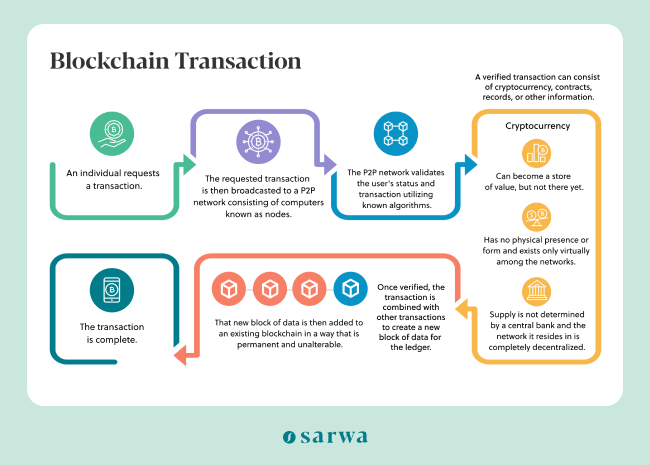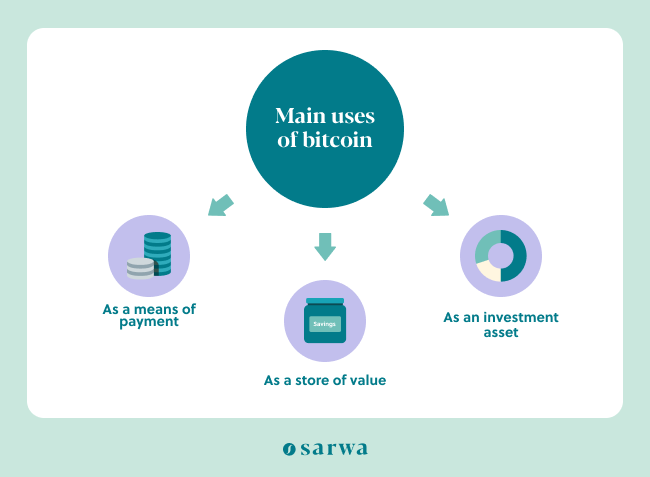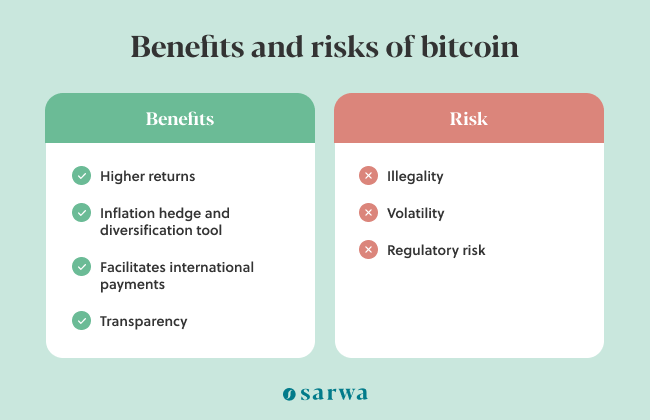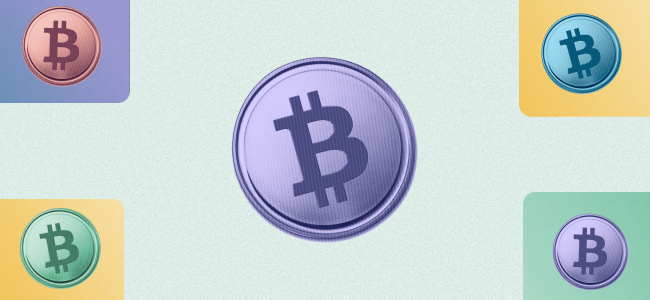Since its crea in 2009, bitcoin has quickly risen to become a household name among investors and the general public. But what is bitcoin beyond all of the media hype, and how should you approach the cryptocurrency as an investor today?
Though it has now become popular as an investment asset, bitcoin is not just another investment. Bitcoin was born as an alternative digital currency, and it’s impossible to get a good grasp of what bitcoin’s value is today without understanding the original intentions of its founder(s).
In this article, we will take a more comprehensive view of what bitcoin is so you can understand its current potential risks and rewards, as well as ultimately decide whether you should invest in it or not.
We’ll cover the following:
- What is bitcoin: A brief introduction
- The bitcoin system: Introduction to blockchain
- What are the main uses of bitcoin?
- Benefits and risks of bitcoin
- The future of bitcoin
[Do you want an exposure to bitcoin in your investment portfolio? With Sarwa, you can invest directly in bitcoin, as well as other cryptocurrencies through the Sarwa trading app.]
1. What is bitcoin: A brief introduction
At its core, bitcoin is a digital currency. As a currency, it was originally designed to facilitate transactions between buyers and sellers. And as a digital currency, bitcoin was created to do this in a way different from all traditional fiat currencies (that is, the dollar, pounds, dirham, etc.) that have come before it.
How then is bitcoin, as a digital currency, different from traditional fiat currencies?
It comes down to the unique technology that supports bitcoin.
First, bitcoin uses a technological system called cryptography.
Simply put, cryptography is a “technique to send secure messages between two or more participants—the sender encrypts/hides a message using a type of key and algorithm, sends this encrypted form of message to the receiver, and the receiver decrypts it to generate the original message,” according to Investopedia.
The keywords here are “encrypts” and “decrypts.”
Using a plain language example, this is like a husband sending a coded message to his wife (by encrypting it) that other people cannot understand except the wife (who can decode it).
One of the cryptography methods used by bitcoin is called hashing. With this technique, the identity of the sender and receiver of bitcoin is converted to a series of codes (known as public keys), through which transactions take place.
For example, instead of a fiat currency transaction that shows that “Mr. James sends AED 5,000 to Mrs. June,” with hashing a bitcoin transaction shows what is known as a private key, which looks like this: “15rf… sends BTC 0.000034 to 25ad…”.
In other words, hashing creates anonymity in financial transactions.
The private key is the counterpart of the public key that a bitcoin owner uses to access his or her bitcoin wallet (where their bitcoin is kept).
While the public key is known to whoever you send it to – it’s your public identity – the private key is known only to the bitcoin owner.
Consider the public key as your bank account number, and the private key as the password to your internet banking or ATM card.
Bitcoin’s anonymity
One of the highlights of bitcoin at its inception was anonymity.
Due to its use of cryptography, the identity of bitcoin users are protected. This means that the government or any other person can’t connect a particular transaction to a particular person (only to public keys).
This anonymity has been of great appeal to libertarians who believe that what people do privately is their business and not the government’s. However, it has also fostered illegal transactions.
The history of bitcoin
Before we go forward, a few words about the history of bitcoin.
Prior to the invention of bitcoin, other types of cryptocurrencies had attempted to create a digital alternative to traditional currencies.
In 1997, Adam Back created Hashcash. It used the hash system explained above as a way to limit email spam, and also required a certain amount of digital computation (a kind of mandatory computing work, also known as ‘mining’) before sending an email. The execution of this computation is proof to the recipient that the email is not coming from a spammer.
B-money was created in 1998 by Wei Dai as an anonymous money distribution system. It was designed as a “a scheme for a group of untraceable digital pseudonyms to pay each other with money and to enforce contracts amongst themselves without outside help,” according to Wei Dai.
In the same year, Nick Szabo also introduced bit gold as a digital and virtual currency. It also sought to combine various elements of cryptography and mining to create a decentralised money system.
Unfortunately, neither b-money nor bit gold was implemented.
Then came bitcoin.
Bitcoin.org was registered on August 18, 2008 and a whitepaper (Bitcoin: A Peer-to-Peer Electronic Cash System) describing what the new digital currency was all about was then published by Satoshi Nakamato on the site on October 31, 2008.
Until today, no one knows who this person (or persons) are.
The first bitcoin, Block O (also known as the genesis block), was mined on January 3, 2009 and the bitcoin software was launched five days later.
Early on, the supply of bitcoin was pegged at 21 million BTC. According to CNBC, a US news network, 90% of the total supply has already been mined as at April 7, 2022. However, the last bitcoin is not expected to be mined until the year 2140.
The satoshi is the smallest unit of a bitcoin and it is 0.00000001 BTC. This means that users who can’t trade a single BTC can trade values anywhere between a satoshi and a single BTC.
How then did bitcoin become so popular?
Before we get into that, some words about blockchain technology, which gives bitcoin its second key feature: decentralisation.
2. The bitcoin system: Introduction to blockchain
A blockchain is a chain of blocks linked together with one another. In blockchain technology, a block contains a series of transactions. Once a block has been filled up, another block is created with a link to the previous one and the next one.
At its core, blockchain is a digital ledger. Instead of recording transactions on a physical ledger, blockchain provides a digital option.
For a transaction to be recorded on a block, a computer system (also called a node) somewhere in the world must solve a certain computational challenge. This process is also referred to as bitcoin mining. As the node solves the challenge, the relevant transaction is recorded on a block and new bitcoin is mined to reward the node.
Below is a helpful infographic to further illustrate the blockchain network:
The blockchain network

Source: Investopedia
There are 15,471 nodes all over the world, according to Bit Nodes, a website that keeps track of the bitcoin network. This means that instead of one central authority, there are more than 15,000 anonymous computer systems recording and verifying transactions at any given time.
Bitcoin is therefore a decentralised system that does not require a central governing authority like fiat currencies do.
Because of decentralisation, anyone can verify or confirm that a bitcoin transaction has taken place and has been included in the block. Moreover, since no parties in a transaction knows which node is recording it on the block, no one can manipulate the system to his or her favour.
In fact, for anyone to compromise the blockchain network, they must have access to more than 50% of all available nodes. Though this is highly unlikely, even in the case of it, bitcoin miners would only need to move to another blockchain.
This decentralisation is also the reason why bitcoin can maintain a fixed supply of 21 million BTC. Unlike central banks that increase money supply when they want, no single central authority can increase bitcoin’s supply. Bitcoin can only be mined as nodes all over the world record transactions on blocks and its supply is fixed.
The combination of anonymity and decentralisation was responsible for the original popularity and success of bitcoin. “Bitcoin’s unique characteristics enabled it to immediately attract public attention since it promised to solve the inefficiencies of traditional currencies,” according to Daily Cal, a US news agency.
Analysts also believe that the frustrations from the 2008/2009 financial crisis made bitcoin’s birth a welcoming development for many.
We can see this in its price history.
[For more on the blockchain network and its role in cryptocurrencies, read “What is Cryptocurrency? A Beginner’s Complete Guide”]
One BTC was worth $0.09 as at July, 2010. Three months later, it was worth $0.10. Six months later, bitcoin hit the $1 mark – the beginning of a bull market that saw it reach $32 by June, 2011.
Then by April 1, 2013 one BTC hit $100.
This was when it began to draw the interest of tech professionals and finance experts for its investment value. By November that year, bitcoin was already worth $1,000, though it would fall and end the year at $530.
Bitcoin would not hit the $1,000 mark again until January 2017. This began a bullish run that led it to $19,000 at the end of the year. Between 2018 and 2019, prices fluctuated.
The next bullish run occurred when COVID-19 led to fears of more inflationary pressure on the US dollar. Bitcoin was seen as a safe haven, a store of value. It ended 2020 at $29,374. By November 2021, bitcoin had hit a peak of $68,789.
Since then, there has been a downward trend and prices have stabilised. At the time of writing, a bitcoin is worth $40,813.
3. What are the main uses of bitcoin?
While anonymity and decentralisation have been the key features of bitcoin, those features are irrelevant in and of themselves unless we consider the uses of bitcoin they made possible.
So, in understanding what is bitcoin beyond the media hype, we must consider its several main uses today:

Bitcoin as a means of payment
Bitcoin started life as a currency, a means of payment for financial transactions between parties.
It’s still a useful means of exchange that facilitates transactions (especially international ones) outside of government-imposed regulations.
Though bitcoin has enabled more local and foreign transactions and improved the ease of exchange, it is also capable of being used for illegal transactions.
A 2019 academic study published on Oxford Academic estimated that around $76 billion worth of illegal transactions, representing 25% of all users, are carried out every year in bitcoin.
Moreover, the global adoption of bitcoin as a means of payment has been a bit slow despite El Salvador’s decision to use bitcoin as a legal tender. In 2021, Triple A, a crypto payment gateway provider, estimated that only 18,000 businesses accept cryptocurrency payments globally. A 2021 study by Deutsche Bank reported by Market Watch also showed that only about 2% of bitcoin transactions are payments for transactions.
Various reasons have been suggested for this slow adoption: low transaction speed (it can take between 10-30 minutes before a transaction is concluded), high transaction costs (the average transaction fee paid on bitcoin transactions in 2021 was $59), and extreme volatility (as you can see in the bitcoin price history section above).
Bitcoin as a store of value
Something is considered a good store of value if it can be used in the future without a deterioration in its value.
The ability of central governments to increase the supply of fiat currencies (thereby reducing its value) have made them a poor store of value. In contrast, bitcoin has a fixed supply and no one can increase its supply.
Consequently, bitcoin can keep and increase its value in the future, responding only to changes in demand.
Some investors have therefore seen bitcoin as an investment asset they can fall back to when inflation hits in the economy. This role (acting as a hedge against inflation) has been traditionally played by gold, which is why many have dubbed bitcoin the “digital gold.”
However, Jiro Kondo, assistant professor of finance at McGill University and Head of Portfolio Construction at Sarwa, once warned that “the link between bitcoin’s finite supply and its effectiveness as an inflation-hedge is still theoretical. We don’t have historical evidence to back up this hypothesis because inflation expectations have been fairly low and stable during the period that bitcoin has been meaningfully traded [e.g., ’15 and beyond]. Bitcoin still has a very long way to go to reach true ‘gold-like’ status and there’s no guarantee that the recent convergence trend will continue.”
Though bitcoin reached its peak in November, 2021, it has lost significant value since then due to “geopolitical tensions” and “climbing inflation,” according to CNBC. The first time that inflation rose significantly, bitcoin was unable to maintain its price.
Bitcoin as an investment asset
Bitcoin has become popular as an investment asset through which many people have made millions.
Apart from the millions made by those who entered the market early, bitcoin has also posted better returns than other assets even when it became more stable. In 2021, bitcoin returned 70% while the S&P 500 returned 28% and gold lost 7%. According to SoFi, a personal finance company, bitcoin’s price has compounded by 100-200% every year.
With better returns than the stock market, many institutional investors have entered and are entering the bitcoin market. Consequently, bitcoin has come to claim a popular following as an investment asset.
“As compared to gold and other assets, I suspect that people will increasingly see bitcoin as a safer and more reliable investment in terms of storing wealth while also getting solid returns in terms of price movements,“ said Michal Cymbalisty, founder of Domination Finance, a decentralised exchange.
Aside from its high returns, some also see bitcoin as a way to diversify their portfolio and further reduce their investment risk. Data from Morning Star that was analysed by ETF Trends between 2012 and 2020 has shown almost-zero correlation between bitcoin with stocks (0.01) and bonds (0.02). If bitcoin can keep this almost-zero correlation, many will keep seeing it as a good diversification tool.
[For more on why bitcoin is an investment asset, read “Why Invest in Bitcoin? Understanding The Value of “Digital Gold”]
4. Benefits and risks of bitcoin
The benefits of bitcoin are straightforward. They include:
- Higher returns: As we have seen, bitcoin tends to outperform the overall stock market, which is the most profitable of the traditional investment strategies.
- Inflation hedge and diversification tool: Bitcoin has a theoretical ability to hedge against inflation due to its limited supply. It has also shown itself to be a good diversification tool between 2012 and 2020. However, since November 2021 bitcoin has lost significant value since then due to numerous factors, including geopolitical tensions and rising inflation.
- Facilitates international payments: Bitcoin has helped to facilitate international transactions without the common regulations imposed by central governments. Despite its high transaction fees, it has also proven to be cheaper than regular payment methods.
- Transparency: Every transaction on a block in a blockchain is publicly available for verification and confirmation of ownership. Though transactions cannot be traced to a person (say Mr. Jamal), it can be traced to the relevant public key. This means that when disagreements occur between the two trading parties, the details of the transaction and ownership of the relevant bitcoin can be publicly confirmed.
Despite its benefits, bitcoin comes with certain risks that all investors should keep in mind:
- Illegality: As said above, anonymity and decentralisation can become a tool to accomplish various illegal and nefarious activities.
- Volatility: In the section dealing with bitcoin price history, we saw how bitcoin price can rise and fall significantly within a few weeks and months. When this happens on the downside, it can mean significant loss of money. For example, bitcoin lost 80% of its value in just a day in April 2013.
- Regulatory risk: Though El Savador has accepted bitcoin as a legal tender, China and eight other countries have banned cryptocurrency in general. US regulatory agencies like the SEC (Securities and Exchange Commission), the FINRA (Financial Industry Regulatory Authority), and the CFPB (Consumer Financial Protection Bureau) are wary of the decentralised nature of bitcoin and planning regulations that will protect consumers and the society.
On March 9, 2022, the US government also issued six-pronged regulations of cryptocurrency transactions.
No one knows what regulations will appear in the future and investing in bitcoin will always include regulatory risk.

5. The future of bitcoin
What then is the future of bitcoin?
It’s hard to say. We have seen how bitcoin can yield high returns but its use as an inflation-hedge and a diversification tool still needs to be firmly established over time.
We also don’t know if regulations will slow down or disappear, if other nations follow in the way of El-Savador, or if security concerns will increase and nations instead follow in the way of China by implementing complete bans.
Similarly, will the acceptance of bitcoin as a means of payment increase or will it only remain an investment asset that thrives on speculation?
To become a better means of payment, bitcoin will have to increase transaction speed and lower transaction fees. Will it be able to do this?
What about volatility? Can bitcoin become more stable, making it attractive to more conservative investors?
Of course, various people have different answers to these questions.
On the one hand are crypto-enthusiasts who believe that the future is positive. An example is Chakib Bouda, CTO of Rambus, a US-based payments firm, who expects that in 10 years’ time, “bitcoin will become mainstream and have a remarkably different reputation.”
Citi Bank, a major US-based bank, also believes that bitcoin can become more mainstream, becoming essentially “the currency of choice for international payment,” especially as institutional investors like Paypal and Tesla invest in it.
On the other hand are critics.
Paul Krugman, a Nobel-prize winning Economist, has seen parallels between crypto and the mortgage crisis that led to the 2008/2009 crisis, calling them “speculative products.” Bill Gates has also complained about the energy consumption involved in the mining of bitcoin and other cryptos.
The point here is that no one can be sure what the future holds for bitcoin. This is why financial advisors have always advised circumspection when it comes to bitcoin investing.
The general wisdom is still that if you want to invest in bitcoin, you should limit it to 5-7% of your entire portfolio.
[For other bitcoin trading advice, read “Bitcoin Trading Advice: The Do’s and Don’ts of Trading Bitcoin”]
At Sarwa, this is exactly what we have done. We provide an opportunity for investors who are positive about bitcoin to include it as 5% of their portfolio.
We are also launching a service to enable investors to invest in multiple cryptocurrencies, and at higher levels, should their appetite for risk be high.
[Are you willing and ready to invest in bitcoin as part of your investment strategy? Schedule a free call with a Sarwa Wealth Advisor and we’ll help you get started]
Takeaways
- Bitcoin is a digital currency created by Satoshi Nakamoto in 2009.
- Bitcoin uses cryptography and blockchain technology to provide anonymity and decentralisation, two features that have been crucial to its success.
- Today, bitcoin is used as a means of payment, a store of value, and an investment asset.
- Bitcoin provides an opportunity to earn high returns, get a hedge against inflation, diversify your portfolio, make international payments cheaply and more comfortably, and be free from government intervention.
- Nevertheless, bitcoin is still very volatile, open to hacks and frauds, and is the subject of continuous regulation discussions.
